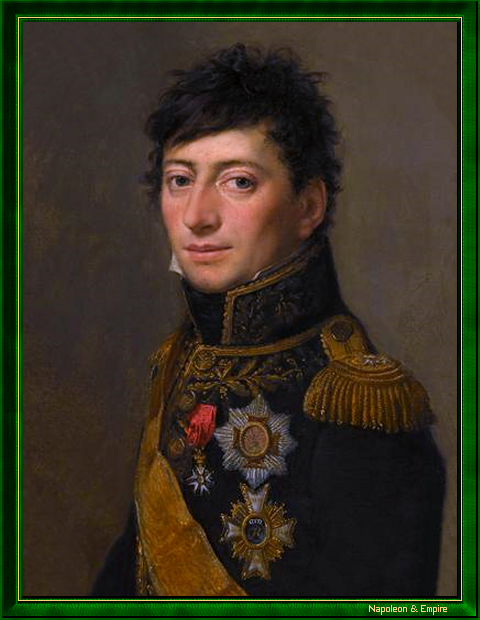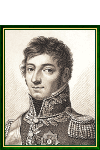Charles Lefebvre-Desnouettes
Count of the Empire
Pronunciation:

Charles Lefebvre-Desnouettes (or Desnoëttes) was born on September 14, 1773 in Paris, into the capital's petty bourgeoisie, where his father was a cloth merchant.
With little interest in studies, he joined the Paris National Guard in December 1789, then fought from 1792 to 1797 in the armies of the Alps, of the North, of Sambre et Meuse and of Rhin et Moselle, before moving on to the Army of Italy, taking part in the Battle of Marengo on June 14, 1800.
He entered the service of First Consul Napoleon Bonaparte in 1800.
From 1802 to 1804, he commanded the 18th Dragons in the Armée des Côtes de l'Océan, then distinguished himself at the battles of Elchingen on October 14, 1805, and Austerlitz on the following December 2.
On July 1, 1806, Charles Lefebvre-Desnouettes married Marie-Louise-Stéphanie Rollier, fourteen years his junior, daughter of Marie Benielli, first cousin of Napoleon Bonaparte. The ceremony took place in the chapel of the Hôtel Thélusson, owned by Joachim and Caroline Murat. As a wedding gift, the Emperor gave the couple his own house on rue Chantereine, where he himself had become engaged to Joséphine de Beauharnais.
Promoted to Major General in 1808, Lefebvre-Desnouettes distinguished himself in Poland and was elevated to the dignity of Count of the Empire.
He then fought in Spain, but was wounded and taken prisoner by the English at Benavente on December 29, 1808. Paroled to England, he escaped in the spring of 1812 to take part in the French Invasion of Russia. At the end of the retreat, he accompanied the Emperor on his departure from Smorgoni, with Grand-Ecuyer Armand de Caulaincourt and Count de Lobau, escorted by a detachment of Imperial Guard cavalry.
In 1813, Lefebvre-Desnouettes fought victoriously in Saxony, and fought throughout the campaign in Northeast France the following year. Although wounded at Brienne, he fought bravely at La Rothière and Montmirail. After the first abdication of Napoleon, he commanded the cavalry escort that accompanied the fallen Emperor to Roanne on the road to exile.
Appointed Chevalier de l'ordre de Saint-Louis and commander of the Corps-Royal des Chasseurs à cheval during the First Restoration, he nevertheless rallied to the Emperor at the start of the Hundred Days, and was elevated to the dignity of Pair de France by Napoleon on June 2, 1815.
He commanded the Vieille Garde light cavalry division in the Belgian Army, and fought under Marshal Michel Ney at Fleurus, Quatre-Bras and Waterloo, where he was again wounded.
As one of the traitors named in the royal decree of July 24, 1815, he had to go into hiding, then leave France for the United States, where he became President of the Vine and Olive Colony in Alabama. He was sentenced to death in absentia in July 1816.
Warned of his imminent rehabilitation, he sailed for Amsterdam, but died on April 22, 1822 when his ship, the Albion, sank off Kinsale [Cionn tSáile], Ireland.
"General Lefebvre-Desnouettes" by H. Weingandt (1784 - ?).

Charles Lefebvre-Desnoëttes received 180,000 francs in Napoleon's will. His heirs benefited.
Lefebvre-Desnouettes' name (spelled "LEFÈVRE DESNte") is inscribed on the 31st column (west pillar) of the Arc de Triomphe de l'Étoile .
The general's widow had a white building erected at Sainte Adresse, near Le Havre, to warn sailors of the dangers of the coast, nicknamed "Le pain de sucre" (the sugar loaf) because of its shape, and was buried there.
A street in the 15th arrondissement of Paris is named after Desnouettes.
Detailed military career
Combat wounds
Wounded before Saragossa, in June 1808.
Wounded by a pistol shot on December 29, 1808 at Benavente (Spain).
Wounded by two bayonet shots in front of Brienne on January 29, 1814.
Wounded at Mont-Saint-Jean (Waterloo) on June 18, 1815.
Captivity
Captured on December 29, 1808 by the British at Benavente (Spain).
First engagement
In the National Guard of Paris in December 1789.
Career development
Hunter on September 15, 1792
Second lieutenant in February 1793.
Captain in 1800.
Squadron commander (Commandant) in 1801.
Brigade commander (Colonel) in 1802.
Brigadier General, September 19, 1806.
Major General in Westphalia on December 29, 1807, confirmed in France on August 28, 1808.
Service record
Hunter in the Allobroge Free Legion on September 15, 1792.
5th regiment of dragoons, February 1793.
Armées Nord, Sambre et Meuse and Rhin et Moselle between 1793 and 1797.
Army of Italy in 1797.
Aide-de-camp to the First Consul in 1800.
On the Consular Guard staff, then in the elite gendarmerie legion in 1801.
Commanded the 18th Dragons in the Ocean Coast Army from 1802 to 1804.
Squire cavalcadour to Napoleon in 1804.
With the Grande Armée, 1805 campaign.
In the service of the King of Westphalia in November 1807.
Major-colonel des chasseurs à cheval de la Garde impériale in 1808.
Army of Spain, 1808.
In the Grande Armée, commanding the Garde chasseurs à cheval during the 1812 campaign.
Belgian Army, commanding the Vieille Garde light cavalry division in June 1815.
Awards
Count Lefebvre-Desnouettes and the Empire on March 19, 1808.
Commander of the Legion of Honor on December 25, 1805 (struck off the list of the Legion of Honor on December 17, 1816).
Commander of the Order of the Lion of Bavaria, Grand Esquire of the Crown of Westphalia in 1807-1808.
Grand Cross of the Order of Reunion on April 3, 1813.
Chevalier de l'Ordre royal et militaire de Saint-Louis on July 19, 1814.
Peer of France, June 2, 1815.
Other portraits

"Charles Lefebvre-Desnouettes". Nineteenth Century etching.